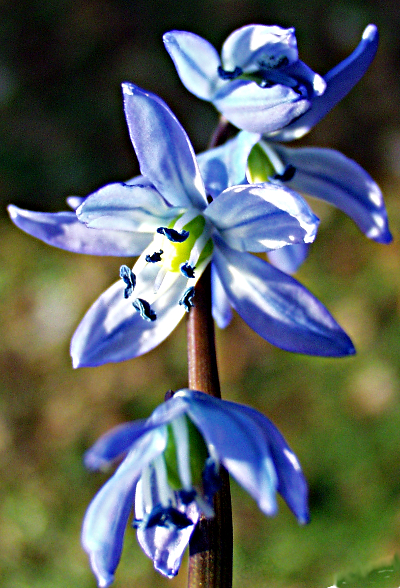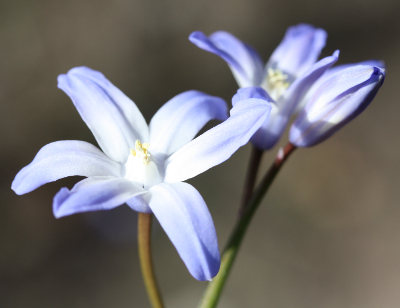Scilla, squill, glory-of-the-snow |

Inflorescence of the Siberian squill (Scilla siberica)

Inflorescence
of the hybrid glory-of-the-snow
(Scilla siberica x
luciliae)
Only recently the genus Chionodoxa Biss. was integrated in Scilla. They differ from Scilla by a cone in the center of the flower, which consists of the ovary and of the surrounding petaloid broadened stamensBlooming period:Height:Height: (corolla appendage) and of the spliced blossoms base. In English, the representatives of the former genus are called glory-of-the-snow after gr. chion (snow) and gr. doxa (gloss, glory, pride).
Originally native to Eurasia and Africa the genus includes about 30 species, some of which are are found worldwide as ornamental plants. The perennials are herbaceous and possess rounded or oval underground bulbs, consisting of free scales. The bulbs are surrounded by a brown or transparent, sometimes frail skin, the tunic. There are formed a few basal, long narrow leaves which are parallel-veined, unstalked and entire. They stand upright or lie the ground.
The leafless stalks rarely bears only a single stalked flower, usually it possess additional lateral flowers. The axis of the resulting racemose inflorescence is called flower scape. The pedicels are sometimes surrounded by bracts. The 6 upright, spreading or recurved, more or less similar shaped tepals are blue, blue with a white background, reddish or rare white. At the base they are free or fused urn-shaped.
At the top of the corolla tube or at the base of the petals arise 6 more or less unequal, incurvate stamens whose filaments are sometimes widened. The superior ovary, consisting of 3 carpels, is then covered by the broad stamens. The ovary bears a simple style.
After pollination by bees, bumblebees, moths or flies a dry capsule fruit develops that opens with 3 valves and releases 3–30 spherical or egg-shaped seeds that possess a so-called elaiosome which serves to spread by ants. Vegetative the genus Scilla multiply by forming daughter bulbs.
| Floral formula: |
| * [P(3+3) A3+3] G(3) superior
or * [P3+3 A3+3] G(3) superior |
Historical publications
Leonhart Fuchs (1501–1566) treated the genus Scilla together with Muscari under the name of "Mertzenblum" (March flower). He distinguished three different varieties of Scilla bifolia: The first usually had only two leaves and star-shaped flowers (klein blaw Mertzenblum männle) the other possess three leaves and had brighter flowers (klein blaw Mertzenblum weible). Another one look very similar to the latter one, but possessed white flowers and had been called by Columella Nivea Hyacinthum.
Meaning of the species names
- luciliae: named after Pierre Edmond Boissier's wife Lucile
- sardensis: named after the now Turkish town Sardis (Salihli)
- siberica: lat. sibericus = siberian
- siehei: named after the Berlin botanist Walter Siehe (1859–1928)
Interesting notes
Squills are not native to Northern Germany. The Scilla species encountered outside from gardens are thus feral specimens of ornamental plants and their descendants.